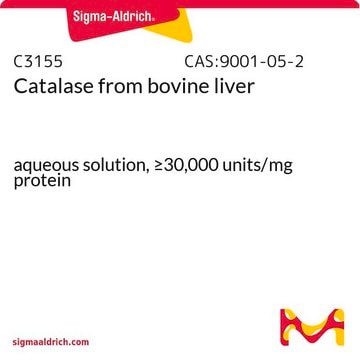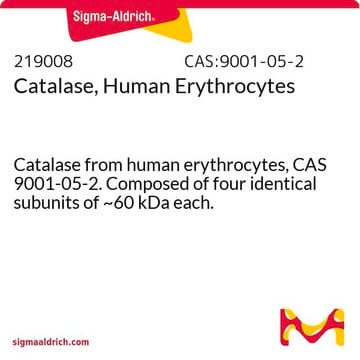C4963
Catalase−polyethylene glycol
lyophilized powder, ~40,000 units/mg protein
Synonym(s):
PEG-Catalase
Sign Into View Organizational & Contract Pricing
All Photos(1)
About This Item
Recommended Products
form
lyophilized powder
Quality Level
specific activity
~40,000 units/mg protein
mol wt
PEG 5,000
composition
Protein, ~50% E405
extent of labeling
~40 mol PEG per mol protein
matrix attachment
secondary amine linkage.
storage temp.
−20°C
Looking for similar products? Visit Product Comparison Guide
Application
Pulmonary artery endothelial cells treated with PEG-catalase showed effective inhibition of 20- HETE (hydroxyeicosatetraenoic acid)-induced increase in fluorescence. However, the experiment excludes potential nonspecific fluorescence of DCF (dichlorofluorescein). This experiment studied the effect of 20-HETE on superoxide production and NADPH oxidase activation.
Biochem/physiol Actions
Catalase from bovine liver catalyzes the decomposition of H2O2 into water and oxygen. It is a tetramer consisting of four equal subunits with a molecular weight of 60 kDa each. Each subunit contains iron bound to a protoheme IX group. The enzyme also strongly binds NADP, which is in close proximity to the heme group. Catalase activity is constant over the pH range of 4.0-8.5. The pI is found to be 5.4. The enzyme activity is inhibited by 3-amino-1-H-1,2,4 triazole, cyanide, azide, hydroxylamine, cyanogen bromide, 2-mercaptoethanol, dithiothreitol, dianisidine, and nitrate. Incubation of catalase with ascorbate or ascorbate/Cu2+ results in degradation of the catalase molecule. It does not require any activators.
Packaging
Package size based on protein content
Other Notes
Catalase from bovine liver coupled to methoxy-polyethylene glycol.
Physical form
Contains PEG plus 5% citrate buffer salts
Storage Class Code
11 - Combustible Solids
WGK
WGK 3
Flash Point(F)
Not applicable
Flash Point(C)
Not applicable
Personal Protective Equipment
dust mask type N95 (US), Eyeshields, Gloves
Certificates of Analysis (COA)
Search for Certificates of Analysis (COA) by entering the products Lot/Batch Number. Lot and Batch Numbers can be found on a product’s label following the words ‘Lot’ or ‘Batch’.
Already Own This Product?
Find documentation for the products that you have recently purchased in the Document Library.
Customers Also Viewed
Jeremiah D Keyes et al.
Free radical biology & medicine, 112, 534-543 (2017-08-28)
ERK-dependent signaling is key to many pathways through which extracellular signals are transduced into cell-fate decisions. One conundrum is the way in which disparate signals induce specific responses through a common, ERK-dependent kinase cascade. While studies have revealed intricate ways
Joe Nassour et al.
Nature communications, 7, 10399-10399 (2016-01-30)
The main characteristic of senescence is its stability which relies on the persistence of DNA damage. We show that unlike fibroblasts, senescent epithelial cells do not activate an ATM-or ATR-dependent DNA damage response (DDR), but accumulate oxidative-stress-induced DNA single-strand breaks
Kessiri Kongmanas et al.
Antioxidants (Basel, Switzerland), 10(6) (2021-07-03)
Seminolipid (also known as sulfogalactosylglycerolipid-SGG), present selectively in male germ cells, plays important roles in spermatogenesis and sperm-egg interaction. The proper degradation of SGG in apoptotic germ cells is also as important. Sertoli cells first phagocytose apoptotic germ cells, then
Emeric Deruy et al.
PloS one, 5(9), e12712-e12712 (2010-09-22)
Senescence is a state of growth arrest resulting mainly from telomere attrition and oxidative stress. It ultimately leads to cell death. We have previously shown that, in keratinocytes, senescence is induced by NF-kappaB activation, MnSOD upregulation and H(2)O(2) overproduction. We
Lingli Li et al.
Kidney international, 92(3), 625-633 (2017-04-12)
Myogenic contractions protect kidneys from barotrauma but are impaired in chronic kidney disease (CKD). Since myogenic contractions are enhanced by superoxide but impaired by hydrogen peroxide, we tested the hypothesis that they are counterregulated by superoxide and H2O2 from NOX2/p47phox and/or
Our team of scientists has experience in all areas of research including Life Science, Material Science, Chemical Synthesis, Chromatography, Analytical and many others.
Contact Technical Service










